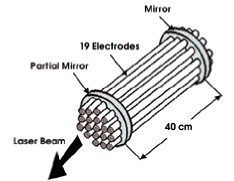
A Smaller, Cheaper Laser Achieves High Power
Michael D. Moss
The trouble with high-power lasers is their size and cost. A 1000-W laser is typically about 1.5 to 2.5 meters long and weighs between 1000 and 1300 kg. A team including a scientist and five engineers claims to have resolved this problem with a 3000-W prototype laser that weighs 100 kg, is 0.5 meters long and costs $30,000. The laser head weighs only 2 kg.
Gil Teva, the inventor of the rotating electric field laser array, or Refla, said the group arranged the electrodes in a circular pattern to maximize the contact between the electrodes and gas inside the laser tube (see figure). Using this arrangement, the area of contact increases proportionally with the profile of the laser, enabling higher output powers in a smaller space. In traditional lasers, the area of the electrodes increases proportionally with the diameter.

Israeli inventors have built a prototype of a smaller, lighter-weight,
lower-cost laser by increasing the area of electrode-to-gas contact
inside the laser tube.
This technique also helps to keep down the cost of Refla lasers. For instance, the 3000-W laser uses 2-in.-diameter mirrors, while conventional lasers need 4-in. mirrors. This difference becomes even more important at higher powers: A 12,000-W Refla laser would require 4-in. mirrors, while traditional lasers would require 16-in. mirrors.
Teva says the Refla laser also reduces the need for large, heavy power supplies, resulting in another cost saving. An excitation method in which voltages in neighboring electrodes are delivered in three phases generates a rotating field in the gas. A 1000-W Refla laser would operate with the power being supplied at a frequency of just megahertz, which can be done with standard semiconductor electronics.
Welding, cutting or marking
These lasers, which can use either CO2 or HeNe gas, could be used in materials processing such as steel production, welding, cutting and marking. Teva said the HeNe laser produces a beam with 1 million times better coherence than diode lasers, making it suitable for high-speed, long-haul fiber optic transfer as well.
The main advantage is its size. The Refla laser's low weight allows the head to be mounted directly onto a robot arm, eliminating the need for delivery systems that can cost more than the laser.
The 3000-W prototype, produced with personal and government funds, has successfully run for short periods. The team, which expects further work on the specialized electrodes to achieve more stable results, is looking for funding to begin mass production.
Published: September 2000